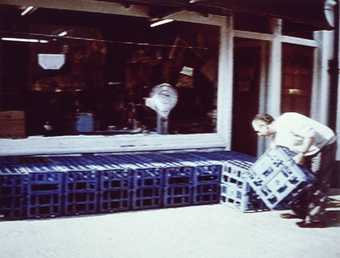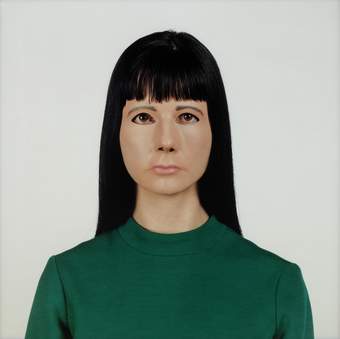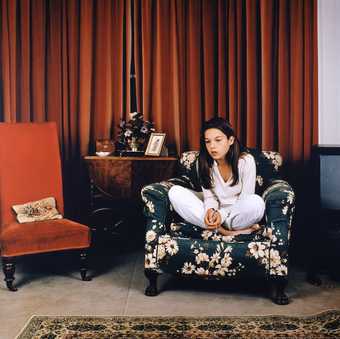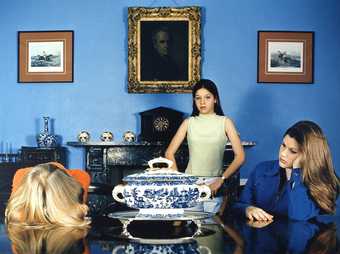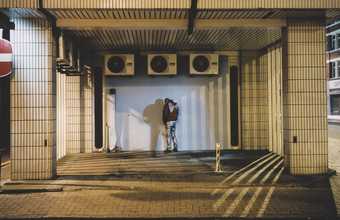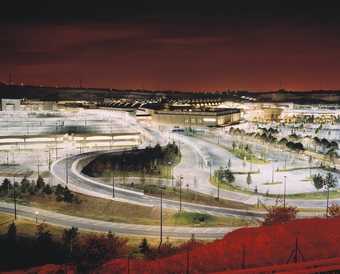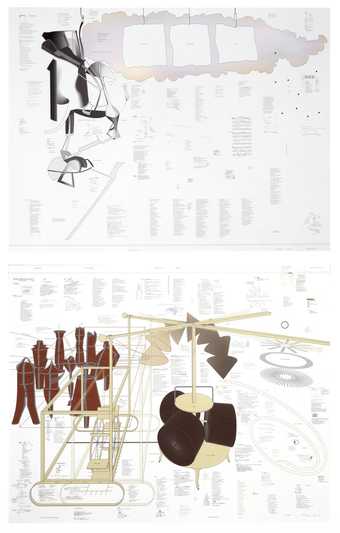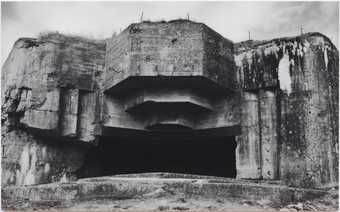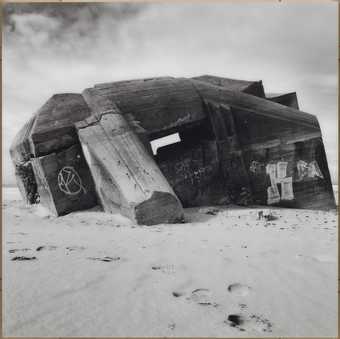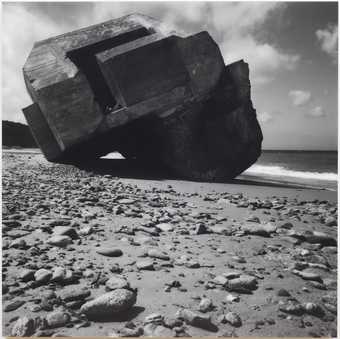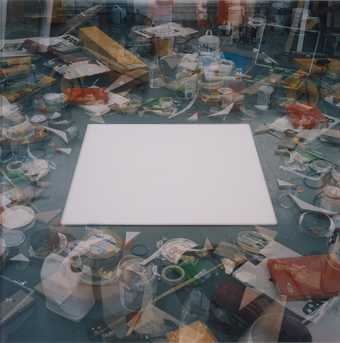
Not on display
- Artist
- Seamus Nicolson born 1971
- Medium
- Photograph, c-print on paper, mounted on aluminium
- Dimensions
- Support: 1012 × 1425 mm
frame: 1055 × 1467 mm - Collection
- Tate
- Acquisition
- Purchased with assistance from donations commemorating the wedding of Juliet Ferguson and Matthew Cestar 2001
- Reference
- P78532
Summary
This photograph shows an apparently inconsequential moment, a young man leaving a late-night London convenience store glancing, as he does so, into his plastic shopping bag. The man behind the counter who can be seen through the window watches the young man as he leaves. The only light is that which emanates from the shop itself, lighting the young man dramatically from one side; the other side of his face is obscured by darkness. It also illuminates the fruit and vegetable stall set out in front of the shop, which suggests a contemporary updating of the still-life tradition in painting. Nicolson wanted to capture the moment between night and day, the task of going to the local corner shop to buy beers for that evening’s party. By staging a casual, throw-away moment and freezing it in time, he elevates it beyond the everyday. Jason appears lost in thought, concentrating on what he is doing and for a moment unaware of the world around him, or that he is being observed. The image is poised between day and night, sharp fluorescent light and deep shadow, manipulation and spontaneity.
Nicolson’s work plays on the narrative potential of restaging moments from everyday life. He deliberately focuses on minutiae, on moments that would be overlooked in ordinary circumstances, moments that are familiar to everyone, having occurred countless times. At the same time Nicolson draws on the activity of the people closest to him, the circles in which he moves. Like the American photographer Nan Goldin (born 1953), he relies on his friends and acquaintances both for inspiration and to be the models in his final works. Yet Nicolson’s photographs sit somewhere in between staged tableau and visual diary. Nicolson’s work can be compared to other recent British photography, particularly the work of Hannah Starkey (born 1971) and Sarah Jones (born 1959) who similarly stage urban situations involving young people. Such staging of events for the camera has a long international history, encompassing the work of Cindy Sherman (born 1954) , Jeff Wall (born 1946), Anna Gaskell (born 1969) or Sharon Lockhart (born 1964). Some of these artists play up the artificial, cinematic aspects of this practice, whilst others such as Nicolson, retain the veracity of a moment documented from everyday life.
Nicolson’s images are the size of large paintings so everything is magnified and colour is intensified. Each detail is heightened and dramatised by the extreme focus it is suddenly placed under. Nothing is happening, or nothing of any note, but the photograph plays up the potential, the tension in the moment of suspended animation. The subject here implies future activity, the party to which the protagonist is heading. Nicolson photographs a moment before the event, an incident that is not usually recorded by the camera. He uses the photograph to imply all that will happen in that future event, without having to depict it, leaving this to the imagination of the viewer and asking them instead to contemplate the more modest, though not mundane, scene he has chosen.
Further Reading:
Christoph Grunenberg and Max Hollein, Shopping: A Century of Art and Consumer Culture, exhibition catalogue, Schirn Kunsthalle Frankfurt, Tate Liverpool, 2002, illustrated p. 246 in colour
Air Guitar: Art reconsidering Rock Music, exhibition catalogue, Milton Keynes Gallery, 2002
Arielle Pelenc and Simon Morrissey, Remix: Images Photographiques, exhibition catalogue, Musée de Beaux Arts, Nantes 1998
Tanya Barson,
February 2003
Does this text contain inaccurate information or language that you feel we should improve or change? We would like to hear from you.
Display caption
Seamus Nicolson's photographs appear to record casually-observed scenes from everyday urban life. Set almost exclusively at night, they seem to capture young people in moments of introspection as they make their way to or from their evening's entertainment. In fact, Nicolson's photographs are recreations of just such glimpsed scenes, stage-managed and directed by the artist after the event. By restaging seemingly trivial events and freezing them in time, Nicolson elevates them beyond the everyday. His portrait of Jason draws our attention to the beauty of the vegetables on display outside the shop, reminiscent of seventeenth-century Dutch still life painting.
Gallery label, September 2004
Does this text contain inaccurate information or language that you feel we should improve or change? We would like to hear from you.
Explore
- architecture(30,960)
-
- public and municipal(2,385)
-
- shop(399)
- formal qualities(12,454)
-
- photographic(4,673)
- food and drink(980)
- bag(44)
- man(10,453)
- Asian(117)
- Jason(1)
- individuals: male(1,841)
- UK countries and regions(24,355)
-
- England(19,202)
- London - non-specific(3,659)
- trading and commercial(1,154)
-
- shopkeeper(16)
You might like
-
Michael Landy CBE RA Appropriation 1
1990 -
Michael Landy CBE RA Appropriation 2
1990 -
Gillian Wearing CBE Self Portrait
2000 -
Rut Blees Luxemburg Tyson/Bombardier
2003 -
Sarah Jones The Sitting Room (Francis Place) III
1997 -
Sarah Jones The Garden (Mulberry Lodge) VI
1997 -
Sarah Jones The Dining Room (Francis Place) I
1997 -
Donald Rodney In the House of My Father
1996–7 -
Seamus Nicolson Ori
1999 -
Dan Holdsworth A Machine for Living: Untitled
1999 -
Richard Hamilton Typo/Topography of Marcel Duchamp’s Large Glass
2003 -
Jane and Louise Wilson Azeville
2006 -
Jane and Louise Wilson Biville
2006 -
Jane and Louise Wilson Urville
2006 -
John Hilliard Division of Labour
2004

